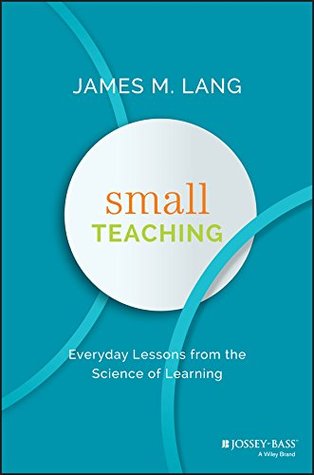More on this book
Community
Kindle Notes & Highlights
Started reading
May 13, 2020
When you are providing opportunities for students to create connections, allow and encourage them to help each other.
The process of creating connections lends itself to collaborative exercises that can revitalize the classroom and inject some fun into learning.
The small teaching strategy to be recommended in this chapter lies at the heart of this section and the heart of the book as a whole: Whatever cognitive skills you are seeking to instill in your students, and that you will be assessing for a grade, the students should have time to practice in class.
“It is virtually impossible to become proficient at a mental task,” wrote cognitive psychologist Daniel Willingham, “without extended practice” (Willingham 2014, p. 107).
If we want students to become proficient at the specific mental tasks that we are planning to assess—such as writing formal essays or responding to essay exam questions, writing lab reports, taking multiple-choice or true–false or
short-answer exams—we have to give them extended practi...
This highlight has been truncated due to consecutive passage length restrictions.
“As far as anyone knows,” wrote Willingham in Why Don't Students Like School, “the only way to develop mental facility [at a cognitive task] is to repeat the target process again and again” (Willingham 2014, p. 115).
This process of combining mental inputs in new ways occurs in our working memories—which, unfortunately, have limited capacity. Willingham called them “a fundamental bottleneck of human cognition” (p. 109).
As Willingham put it, “It is no wonder that students who have memorized math facts do better in all sorts of math tasks than students whose knowledge of math facts is absent or uncertain. And it's been shown that practicing math facts helps low-achieving students do better on more advanced mathematics” (Willingham 2014, p. 114). A
That doesn't mean that students with poor grammar skills can't think effectively or can't also be smart. However, students who struggle with the basic requirement of putting grammatically correct sentences together have to devote their working memory space to that task and don't leave themselves space for the higher order tasks necessary to complete the assignment effectively.
The student who has a strong mastery of grammar and mechanics, by contrast, can devote his working memory space to those more complex tasks.
whatever specific cognitive skills you want your students to develop, they should have multiple opportunities to practice beforehand.
The Power of Mindful Learning,
“One of the most cherished myths in education or any kind of training,” Langer wrote, “is that in order to learn a skill one must practice it to the point of doing it without thinking” (Langer 2007, p. 10).
Asking them to drill the same tasks over and over again puts them on autopilot and prevents them from refining and further developing their skills in the way that experts continually do.
Langer defined a mindful approach to learning as having three characteristics: “the continuous creation of new categories; openness to new information; and an implicit awareness of more than one perspective” (Langer 2007, p. 4).
First, the learner must be willing to shift and develop the categories that will guide her through a cognitive task.
Second, the learner must be attentive to new information that might be blocked from view by her usual approach.
Finally, the mindful learner recognizes that perspectives are always limited and that final conclusions are always provisional.
She accepts the possibility that new and better approaches to a problem might yet arise, and she remains open to the potential value of perspectives she doesn't inhabit.
The three components of mindful learning, taken together, represent both activity and attitude: the activity involves monitoring and questioning one's approach to a routine problem or challenge; the at...
This highlight has been truncated due to consecutive passage length restrictions.
Once you have done this, you might find it surprising to note—as I once did—how many of the skills that you require of students on your assessments are ones you don't normally allow them to practice in your course.
Did you know that research has been conducted on this very issue of whether or not we should read the text on our slides (Miller 2014, p. 154)?
Michelle Miller described as the “‘Goldilocks’ principle with respect to the discrepancy between the narration and the visually presented slide”—they should clearly reference and highlight the key components of what they have put on the slide, but not simply read it out directly (Miller 2014, p. 154).
Although flexible thinking is the essence of mindfulness, flexibility can also be considered a quality of intelligent thinking. We all have a repertoire of lower-level procedures and higher-level strategies that may be tried in novel settings. The larger our repertoire and the less we are attached to any specific procedure or strategy, the more flexible our thinking is likely to be…Our general capacity to sort through these various strategies and procedures and assess which can be applied most appropriately to a novel task is the process usually called intelligent thinking. (p. 113)
In other words, intelligence in the completion of cognitive tasks consists of the ability to step back from our familiar patterns, consider whether alternatives exist, and then recognize whether any of those alternatives might work more effectively.
Why have you chosen to use that strategy for your introduction? What alternatives might you have chosen? Is that the only formula that you could have used to solve this problem? Have you ever encountered a question like this outside of this course? How did you answer it then? If I posed this question to someone who had not taken this course, how do you think they would go about trying to answer it?
Questions like these, designed to push thinkers up to a more aerial view of their practice, may help create the kind of mindful learners that don't lock into familiar patterns and rely on rote repetition to complete their cognitive tasks.


